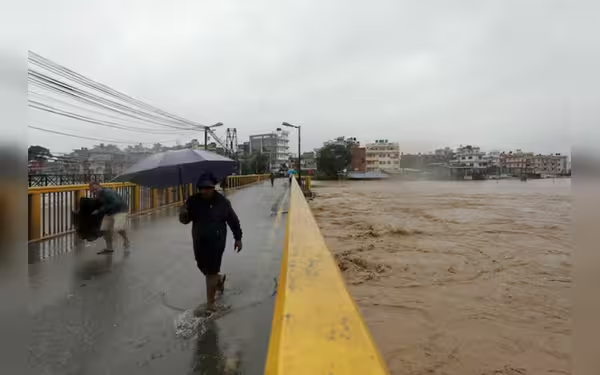Sunday, October 6, 2024 12:28 AM
Nepal Floods Claim 170 Lives Amid Monsoon Deluge
- 170 confirmed dead due to devastating floods.
- Record rainfall leads to widespread destruction.
- Rescue operations underway with over 3,000 personnel deployed.
 Image Credits: brecorder
Image Credits: brecorderNepal faces devastation as floods claim 170 lives, prompting extensive rescue efforts amid record monsoon rainfall.
KATHMANDU: The recent floods in Nepal have left a devastating mark on the country, claiming the lives of at least 170 individuals. This tragedy unfolded as relentless monsoon rains swept across the Himalayan nation, causing widespread destruction and chaos. Floods and landslides are not uncommon in South Asia during the monsoon season, which typically runs from June to September. However, experts warn that climate change is making these natural disasters more frequent and severe.
As residents of Nepal's capital, Kathmandu, returned to their homes, they were met with the harsh reality of mud-caked streets and damaged properties. Entire neighborhoods were submerged, and flash floods surged through the city, leading to significant damage to highways that connect Kathmandu with other regions of Nepal. Kumar Tamang, a local resident, shared his harrowing experience of fleeing his home as the waters rose rapidly. He described the scene upon returning, stating, "This morning we returned and everything looks different. We couldn’t even open the doors to our house; it was jammed with mud." His words reflect the fear and uncertainty that many families are facing in the aftermath of this disaster.
Nepal's Home Ministry has reported that 170 people have lost their lives due to the floods, with an additional 42 individuals still unaccounted for. The situation has prompted a massive response from authorities, with bulldozers clearing blocked highways to restore access. Tragically, at least 35 of the deceased were trapped in vehicles buried by a landslide on a highway south of Kathmandu. The Department of Hydrology and Meteorology has indicated that record-breaking rainfall was recorded in various districts, with Kathmandu airport measuring approximately 240 millimeters (9.4 inches) of rain, the highest since 2002.
The Bagmati River and its tributaries overflowed, inundating homes and vehicles, forcing residents to wade through chest-deep water in search of safety. Bishnu Maya Shrestha, another affected resident, recounted her escape, saying, "We jumped from one roof to another to safety and finally they came with boats to rescue us." This highlights the desperate measures people are taking to survive in such dire circumstances.
In response to the crisis, over 3,000 security personnel have been deployed to assist with rescue operations, utilizing helicopters and motorboats. Humanitarian organizations are also on the ground, providing essential support, including non-food items and hygiene kits. Jagan Chapagain, head of the International Federation of Red Cross and Red Crescent Societies, emphasized the importance of these efforts, stating that staff and volunteers are actively working to help those in need.
As the summer monsoon continues to bring heavy rainfall to South Asia, the region faces the ongoing threat of floods and landslides. This year alone, more than 260 people have died in Nepal due to rain-related disasters. The increasing frequency and intensity of such events raise critical questions about the impact of climate change on the region. It is essential for governments and communities to come together to address these challenges and implement strategies to mitigate the effects of climate change.
The recent floods in Nepal serve as a stark reminder of the vulnerability of communities to natural disasters exacerbated by climate change. As the nation begins to recover, it is crucial to reflect on the lessons learned and to prioritize resilience-building measures to protect lives and livelihoods in the future. The road to recovery may be long, but with collective efforts, hope remains for a safer and more prepared Nepal.













